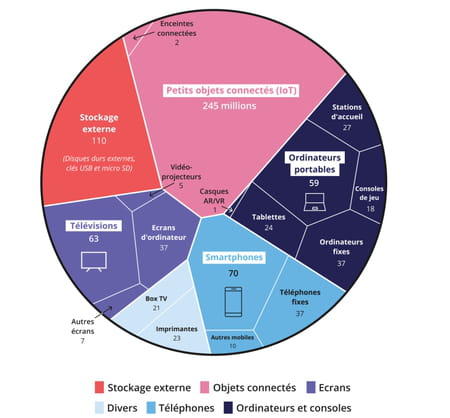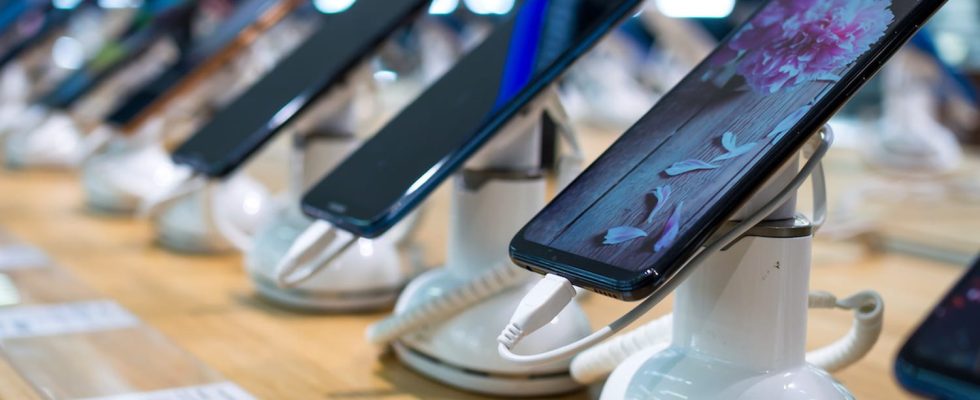Arcep and Ademe are sounding the alarm! If we don’t change our habits, the digital carbon footprint in France could well triple by 2050. But a few measures would limit the damage.
As we face an unprecedented ecological crisis, it is more necessary than ever to question ourselves about the way we consume, including in the digital domain, because electronic devices have a significant impact on the environment. Indeed, computers, televisions, smartphones, tablets and all their accessories currently represent 2.5% of the carbon footprint in France, or the equivalent of 17.2 million tonnes of CO2. And to prepare for the future, in 2020 the Government commissioned a prospective study on the environmental footprint of digital technology in France by 2030 and 2050.
On Monday March 6, Arcep (Electronic Communications Regulatory Authority) and Ademe (Environment and Energy Management Agency) therefore handed over to Christophe Béchu, Minister for Ecological Transition, Agnès Pannier-Runacher, Minister for Energy Transition, and to Jean-Noël Barrot, Minister Delegate for the Digital Transition and Telecommunications, the results of the third part of this study. And as much to say that the projections are far from being reassuring! Far from decreasing, the digital carbon footprint should explode in the years to come, reaching 50 million tonnes in 2050 if we don’t change our habits. In question: the explosion in the use of streaming, equipment in smartphones, computers and various connected objects, but also 5G.
Digital impact: a carbon footprint tripled by 2050
According to the observations of Arcep and Ademe, 80% of the digital carbon footprint currently comes from the manufacture of our equipment, 16% from data centers and 5% from networks. “Even before we use our latest shiny new smartphone, TV or computer, it has already produced nearly 80% of the greenhouse gas emissions it will emit during its (too short) life., says the report. Indeed, the production of a device is the most polluting phase of its existence, because of the extraction of raw materials. Therefore, the longer a piece of equipment is used, the lower its environmental impact will be. And we unfortunately do not catch up on this point since we keep our devices too little: only two and a half years for smartphones, three years for tablets.
Based on these findings, the two organizations were able to define four possible scenarios for 2030 and 2050, ranging from an acceleration of the current trend – the report speaks of “headlong digital ” – to a scenario of very great sobriety – very utopian. In the trend scenario – so if we continue on the same path – digital greenhouse gas emissions would increase by 45% by 2030 to reach 25 million tonnes of CO2 equivalent, with an increase of 4% for energy consumption and 14% for the consumption of metals and minerals By 2050, digital-related greenhouse gas emissions will triple, with an increase of 59% for the consumption of metals and minerals and 79% for energy consumption. Figures that can be explained “by the growth in uses, itself supported by a growing number of data centers“.
But we must not forget that one of the major environmental challenges of digital technology, in addition to this famous carbon footprint, also lies in the availability of metals and other natural resources used for the manufacture of terminals, which are ever more numerous, more powerful and more consumable. , but also on our ability to supply them with energy. “While this digital development makes it possible in part to reduce other environmental impacts in other sectors, the consumption it would generate in terms of electricity and resources in any case raises the question of their feasibility (will it be possible to produce so much electricity or consume so much raw material in a world where tensions are increasing?)”, explains the document. We will therefore have to carefully choose our path to follow…

Digital impact: drastic changes to be made
Thus, the scenario that the two organizations call “Repair bet” would lead to a fivefold increase in the digital carbon footprint compared to 2020. “Lifestyles at the start of the 21st centurye century are saved. But the proliferation of goods consumes a lot of energy and materials with potentially strong impacts on the environment. Society places its trust in the ability to manage and even repair social and ecological systems with more material and financial resources to maintain a livable world. This exclusive support for technologies is a bet insofar as some of them are not mature”notes the report.
AT Conversely, the “Frugal Generation” scenario would lead to halving the digital carbon footprint compared to 2020.“Major transformations in the ways of moving, heating, eating, buying and using equipment, make it possible to achieve carbon neutrality without involving carbon capture and storage technologies, not proven and uncertain on a large scale”, explains the study. To achieve this result, we should begin to question the extent of the development of new digital products or services, and a reduction or stabilization of the number of devices.
This ideal scenario would require taking drastic measures, on the side of consumers as well as companies and manufacturers. This would start by extending the lifespan of equipment by two years – i.e. 7 years for PCs, 8 years for TVs and 4 and a half years for smartphones – by developing the reconditioning and repair of devices so that we can keep it longer – builders should start by stopping planned obsolescence. It would also be necessary to improve the energy performance of network equipment and data center, as well as optimizing the coding of digital services and the management of data flows. Fibre, which consumes much less energy than the copper network used for ADSL, should also become widespread. Finally – and these are measures that currently seem difficult to implement, television sets should be replaced by video projectors and the number of mobile network antennas or the number of equipment should not be increased.

